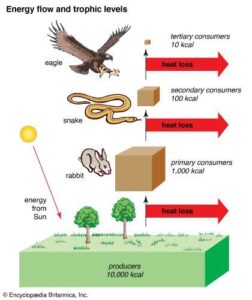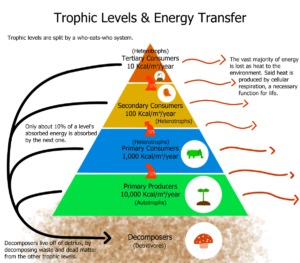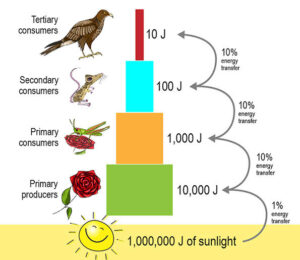Back to: Botany 500 Level
My Afrilearn superstar! How your day dey go? I hope say you dey enjoy the learning journey, because today, we go talk about something wey be the heart of every ecosystem—Energy Flow and Trophic Levels. This na how energy waka from one level to another inside the ecosystem, and I go break am down to make sure say e easy for you to understand and enjoy. Ready? Let’s roll!
Energy flow and trophic levels
What’s Energy Flow in an Ecosystem?
You know say life no fit exist without energy, right? From plants to animals, all living things need energy to survive. For plants, the energy dey come from the sun. When plants do their photosynthesis (like magic), dem use sunlight to make food. Then, the energy from the plants go transfer to other organisms wey chop them.

Energy flow is the way energy dey pass through different organisms in an ecosystem, from the sun to plants, to herbivores, to carnivores, and back to decomposers.
Make we break this energy flow down like Naija stew:
- The Sun – Sunlight na the main source of energy. Without the sun, life no fit happen. The sun provides the energy plants need to make food through photosynthesis.
- Producers (Plants) – Plants na the first level of energy receivers. Dem use sunlight to make food. Think of how cassava, yam, or maize take get energy from the sun to grow.
- Consumers (Herbivores, Carnivores, Omnivores) – These are the animals wey depend on plants or other animals for food.
- Primary consumers (herbivores) eat the plants. For example, goats wey chop grass.
- Secondary consumers (carnivores) eat herbivores. For instance, hawks wey chop rats.
- Tertiary consumers are the top predators. Think of lions wey eat smaller animals like zebras.
- Decomposers (Bacteria and Fungi) – When plants and animals die, decomposers like fungi and bacteria break them down. As they do this, they return nutrients and energy to the soil, where plants fit use am again.

The energy flow goes in a cycle, and no energy fit be wasted. It’s like passing a baton in relay race—energy dey move from one organism to another.
Trophic Levels
Now, make we talk about the trophic levels. Trophic levels are the different steps or levels of energy transfer from one organism to another in the food chain. E dey show who eat who, and how energy dey pass through the system.
- First Trophic Level – Producers (Plants):
Plants and algae dey at this level because dem make food from sunlight. Without producers, there’s no energy for any other organism. - Second Trophic Level – Primary Consumers (Herbivores):
Herbivores like cows, goats, and grasshoppers are the first consumers. Dem eat plants to get energy. - Third Trophic Level – Secondary Consumers (Carnivores):
These animals eat the primary consumers. For example, lizards wey eat grasshoppers or snakes eat rats. - Fourth Trophic Level – Tertiary Consumers (Top Predators):
Top predators like eagles, lions, or sharks sit at the top. Dem no get natural enemies and dey eat other consumers. - Decomposers (Not part of the trophic levels, but important):
Decomposers like fungi, bacteria, and earthworms break down dead plants and animals. While them no eat plants or animals for food, them still help in recycling energy and nutrients back into the system.
Food Chains and Food Webs
The energy flow happen in food chains and food webs. A food chain is a simple, linear sequence of who-eats-who, but in nature, food chains interconnect to form food webs. Food webs show how all the different food chains in an ecosystem are linked together.

Why E Matter to You?
Understanding energy flow and trophic levels help us know how ecosystems work, how animals depend on each other, and how we can protect biodiversity. For instance, if one level of the trophic structure gets affected—like if herbivores dey overhunted—other levels go suffer, and the whole ecosystem fit collapse.
Summary:
- Energy flow is the transfer of energy through different organisms in an ecosystem, starting from the sun to producers, consumers, and decomposers.
- Trophic levels show the steps of energy transfer from producers (plants) to herbivores, carnivores, and top predators.
- Food chains and food webs show how energy flows through the system in an interconnected way.
Evaluation:
- What is the first trophic level in the energy flow system?
- Explain the difference between primary consumers and secondary consumers with examples.
- Why are decomposers important in the energy flow of an ecosystem?
You too much, my Afrilearn hero! See as you don gather all these energy flow ideas like pro! You dey understand the role of each organism and how dem work together to make the ecosystem function. Keep the energy up—because your future is glowing bright. I dey proud of you, and I can’t wait for you to conquer the next lesson! Keep shining, you dey do well!
